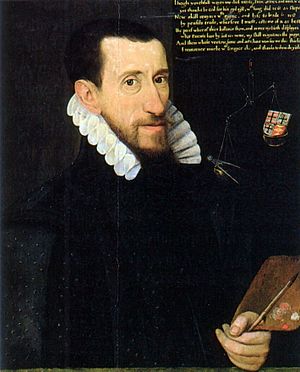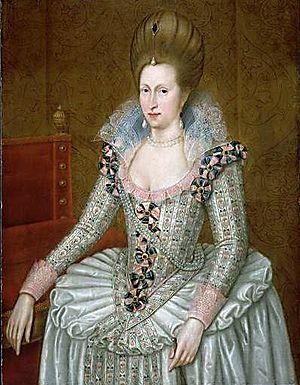Serjeant Painter facts for kids

The Serjeant Painter was a special and important job for an artist who worked for the English King or Queen. This artist was in charge of painting and decorating all of the royal homes, carriages, flags, and more. It was a very good job, earning over £1,000 a year by the 1700s!
The work involved painting palaces, royal boats, and all sorts of decorations for big parties and events. The Serjeant Painter often had to design these decorations too. Over time, the Serjeant Painters did less of the actual painting themselves. Instead, they became more like supervisors. The job eventually stopped being used in the 1700s.
Contents
History of the Royal Painters
The job of Serjeant Painter started in 1511 or 1512 with a painter named John Browne. During the time of King Henry VIII, these painters seemed to be like foremen, guiding other workers. From 1527, better artists were called "King's Painter," like Lucas Horenbout. These artists might have also painted portraits.
George Gower was chosen by Queen Elizabeth I in 1581. In 1603, King James I appointed John de Critz to the job, paying him £40 a year, which was a lot of money! He shared the job first with Leonard Fryer, and then from 1610 with Robert Peake the Elder. Gower, De Critz, and Peake were all well-known artists. Their appointments showed that the Serjeant Painter's job was becoming less about doing the actual painting and more about managing it.
For the famous artist Anthony van Dyck, a new job was created called "Principal Painter in Ordinary." This job paid £200 a year and usually went to portrait painters. This role continued until Queen Victoria's time. By the 1700s, most of the Serjeant Painter's work was done by assistants. In 1720, Sir James Thornhill became Serjeant Painter, and in 1757, William Hogarth took the role.
The last known Serjeant Painter was James Stewart. We don't have many records of him after 1782. It's not clear if the job was officially ended or just stopped being filled.

What Did a Serjeant Painter Do?
The Serjeant Painter's job had many different duties. It wasn't just about painting new portraits. They also had to make copies of royal portraits to send to other royal families. For example, King James didn't like sitting for his portrait, so copies were often needed. They also copied and fixed old paintings in the royal art collection.
Besides portraits, they did many decorative tasks. This included painting scenes for plays and painting royal flags. Sometimes, there was confusion about who should do what job among the artists working for the court.
In 1584, a plan was made to give Serjeant Painter George Gower the only right to paint all portraits of the Queen. However, there was one exception: Nicholas Hilliard. He was allowed to paint small portraits of the Queen using a special technique called "limning." Limning meant painting very detailed miniature portraits. At the time, this was seen as the highest form of painting. Larger paintings, done on easels, were often thought of as more like interior decorating.
In 1606, Hilliard seemed to step on the toes of the Serjeant Painter, John de Critz. Hilliard offered to paint the tomb of Queen Elizabeth. He claimed he could make "more radiant colours like unto enamels." But De Critz reminded him that painting the royal tomb was "within the Serjeant's patent," meaning it was his job.
The writer Horace Walpole shared some interesting details about John de Critz's work. Walpole used notes from George Vertue, who had met people who knew de Critz. Walpole found a note from de Critz himself, where he listed jobs he had finished.
One list was for work on a sun-dial: "For several times oiling and laying with fair white a stone for a sun-dial opposite to some part of the king and queen’s lodgings, the lines thereof being drawn in several colours, the letters directing to the bowers gilded with fine gold, as also the glory, and a scroll gilded with fine gold, whereon the number and figures specifying the planetary hours are inscribed; likewise certain letters drawn in black informing in what part of the compass the sun at any time there shining shall be resident; the whole work being surrounded with a fret painted in a manner of a stone one, the complete measure of the whole being six feet."
Another list was for work on the royal barge (a special boat): "John De Critz demands payment for these parts of work following, namely: For repairing, refreshing, washing and varnishing the whole body of his Majesty’s privy barge, and mending with fine gold and fair colours many and diverse parts thereof, as about the chair of state, the doors, and most of the antiques about the windows, that had been damaged and defaced, the two figures at the entrance being mostly new coloured and painted, the Mercury and the lion that are fixed to the sterns of this and the row barge being in several places repaired both with gold and colours, as also the taffarils on the top of the barge in many parts gilded and scattered with fair blue. The two figures of Justice and Fortitude mostly being quite new painted and gilded. The border on the outside of the bulk being new laid with fair white and trailed over with green according to the custom before—and for buying and colouring the whole number of the oars for the row barge being thirty-six."
Walpole also noted that de Critz painted a gilded "middle piece" for a ceiling and fixed pictures. He also found a record of payment to de Critz for painting and gilding two coaches and a chariot in 1634.
Some people have joked about the Serjeant Painter's job because it included tasks like house-painting, painting boats, and making flags. Art historian William Gaunt even called de Critz's role "mainly that of a handyman."
William Hogarth, who became Serjeant Painter in 1757, even made fun of the job himself. When he got the official document, it called him "Our Trusty and wellbeloved William Hogarth Gentleman." It listed duties like working for the "Office of the Revels" and painting "Our Navys and Shops Barges and Close Barges Coaches Chariots Charoches Litters Wagons and Close Carrs Tents & Pavilions Heralds Coats Trumpets Banners." Hogarth wrote his own funny version of the document, making light of the many different tasks.
Hogarth took over the job from his brother-in-law, John Thornhill. John's father, Sir James Thornhill, had also been a Serjeant Painter. Even though Hogarth's official salary was only £10, the job could be very profitable. Hogarth wrote that he was now "landed as it were and secured from tugging any longer at the ore." He was in charge of all royal painting and gilding jobs, from palace decorations to flags. After paying his workers and a helper, he figured he was making £200 a year profit from the job.
However, the Serjeant Painter's office was not as fancy as Hogarth might have liked. Other artists, like Joshua Reynolds, were hired to paint important members of the court. Reynolds could charge much higher prices than Hogarth because he had direct support from the royal family.
List of Serjeant Painters
- John Browne: He was a heraldic painter since 1502. He was named "King's Painter" in 1511/12 and became the first Serjeant Painter in 1527. He died in this role in 1532.
- Andrew Wright
- "Antony Toto" (Antonio di Nunziato d'Antonio): He was a pupil of Ridolfo Ghirlandajo. He held the post from 1544 until he died in 1554. He was the first Serjeant Painter known more as an artist than just a craftsman.
- Nicolas Lizard: A French artist who held the job from 1554 to 1571.
- William Herne or Heron: From 1572 to 1580.
- George Gower: From 1581 until his death in 1596.
- Leonard Fryer: From 1596 to 1605.
- John de Critz the Elder: From 1603 until he died in 1642. He later shared the role with Robert Peake.
- Robert Peake the Elder: Joined de Critz in 1607 or 1610. He often painted royal portraits, while De Critz managed the decorating of royal homes. Peake died in 1619.
- John de Critz the Younger: Took over from his father in 1642. He likely did most of the work for years before his father died. He died soon after in fighting at Oxford.
- William Dobson: He became the painter for the royal family during the English Civil War (1642–1646). It's not officially recorded if he was Serjeant Painter, but some believed he was.
- Sir Robert Howard: Appointed in 1660 after the English Restoration. He was also a politician and playwright. He resigned in 1663.
- Robert Streater: Appointed in 1663. He was known for landscape painting. He painted the ceiling of the Sheldonian Theatre in Oxford. He died in 1679.
- Robert Streeter, Jr.: Son of the above.
- Thomas Highmore: Serjeant Painter until 1720. He was appointed by King William III.
- Sir James Thornhill: A student of Thomas Highmore, he became Serjeant Painter in 1720. He was knighted that same year. He died in 1734.
- John Thornhill: Son of Sir James, he held the job until shortly before his death in 1757.
- William Hogarth: Brother-in-law of John Thornhill and son-in-law of Sir James. He held the job from 1757 until his death in 1764.
- Benjamin Wilson: Took over from William Hogarth in 1764.
- James Stewart: The last known Serjeant Painter, holding the job until 1782 or possibly later.
See also

